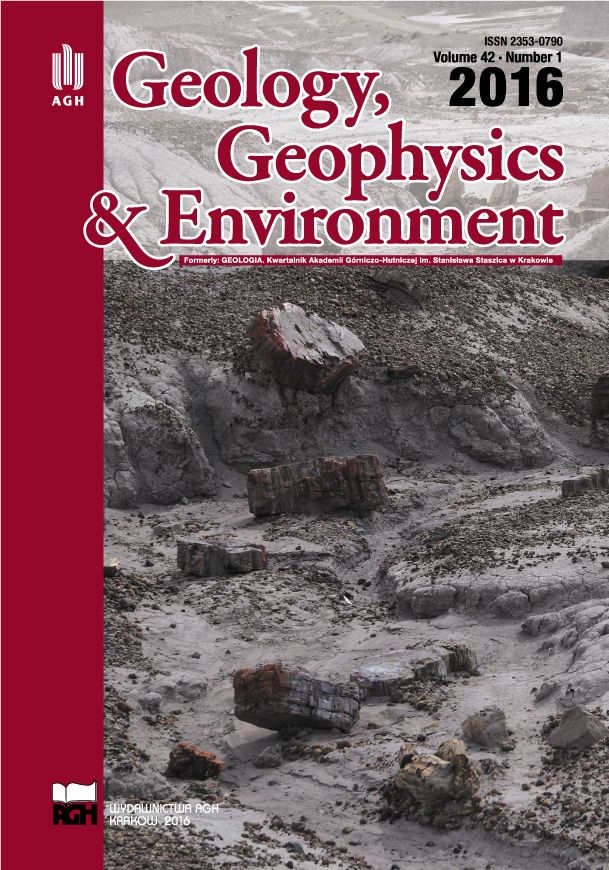Ground Penetrating Radar investigation of limestone karst objects in the Botanical Garden in Kielce
DOI:
https://doi.org/10.7494/geol.2016.42.1.31Keywords:
GPR, karst, cave, Kielce, Botanical GardenAbstract
Ground Penetrating Radar (GPR) is one of the most effective and rapid types of geophysical survey methods. The present study was carried out in the Botanical Garden in Kielce, which is currently undergoing a second stage of infrastructure development. This object is located in the Świętokrzyskie (Holy Cross) Region, characterized by large scale deformations in the development of karst origins. Those structures threaten existing buildings and can be obstacles to newly constructed ones. Radargrams presented in this paper show significant potential of the GPR method in mapping of karst phenomena. Proper acquisition parameters and optimal processing of raw data resulted in a clear image of the structure of rock mass under the Botanical Garden, along acquired profile lines. Additionally, precise GPS coordinate links and established researchers’ experience of conducting this type of surveys helped in the process of mapping the anomalies in the limestone. Under these conditions, the survey minimized the need for a second method and resulted in high quality data acquisition. The study provided information about underlying rock mass structure development and registered anomalies whose origins include voids or caves of karst genesis. The area studied covers a large part of the Botanical Garden. Described anomalies can be dynamic in origin.Downloads
References
Annan A.P., 2001. Ground Penetrating Radar Workshop Notes. Sensors & Software, Ontario – Canada.
Beres M., Luetscher M. & Olivier R., 2001. Integration of ground-penetrating radar and microgravimetric methods to map shallow caves. Journal of Applied Geophysics, 46, 249–262.
Chamberlain A.T., Sellers W., Proctor C. & Coard R., 2000. Cave Detection in Limestone using Ground Penetrating Radar. Journal of Archaeological Science, 27, 957–964.
Derobert X. & Abraham O., 2000. GPR and seismic imaging in a gypsum quarry. Journal of Applied Geophysics, 45, 157–169.
Doolittle J.A. & Collins M.E., 1998. A comparison of EM induction and GPR methods in areas of karst. Geoderma, 85, 83–102.
El-Quady G., Hafez M., Abdalla M. A. & Ushijima K., 2005. Imaging subsurface cavities using geoelectric tomography and ground-penetrating radar. Journal of Cave and Karst Studies, 67, 3, 174–181.
Filonowicz P., 1973a. Objaśnienia do Szczegółowej mapy geologicznej Polski 1:50 000. 815, Arkusz Kielce. Wydawnictwa Geologiczne, Warszawa.
Filonowicz P., 1973b. Szczegółowa mapa geologiczna Polski 1:50 000. 815, Arkusz Kielce. Wydawnictwa Geologiczne, Warszawa.
Kondracki J., 2013. Geografia regionalna Polski. Warszawa, PWN.
Łój M., Gołębiowski T. & Porzucek S., 2014. Geophysical surveys and modelling for recognizing of gypsum karst. Geoinformatica Polonica, 13, 1, 83–97.
Łyskowski M., Mazurek E. & Ziętek J., 2014. Ground Penerating Radar investigation of limestone karst at the Odstrzelona Cave in Kowala, Świętokrzyskie Moutains, Poland. Journal of Cave and Karst Studies, 76, 3, 184–190.
Mazurkiewicz E., Łyskowski M. & Strzępowicz A., 2015. Aplikacja metody GPR do badania dróg na terenach o zwiększonym zagrożeniu deformacjami o genezie krasowej. Logistyka, 4 [CD nr 3 Logistyka – nauka], 9474–9479.
OYO, 1988. OYO Georadar I Manual. OYO Corporation, Tsukuba, Japan.
ReflexW Manual, 2009. User Guide. SandmeierGeo. Karlsruhe, Germany.
Reynolds J.M., 1997. An Introduction to Applied and Environmental Geophysics. John Wiley & Sons, England. Urban J., 2007. Permian to Triassic paleokarst of the Świętokrzyskie (Holy Cross) MTS, Central Poland. Geologia, 33, 1, 5–50.
Śmiech S., 2005. Dokumentacja geotechniczna warunków geologicznych i hydrogeologicznych dla potrzeb zagospodarowania Ogrodu Botanicznego w Kielcach, ul. Bernardyńska, Karczówkowska, Jagiellońska w Kielcach. Przedsiębiorstwo Usług Geologicznych „Kielkard” [unpublished].
Zieliński A. & Janeczko K., 2016. Największe atrakcje turystyczne w województwie świętokrzyskim w opinii turystów. Zeszyty Naukowe – Uniwersytet Szczeciński, Ekonomiczne Problemy Turystyki, 2, 34, 297–307.
Zieliński A., Mazurkiewicz E. & Łyskowski M., 2016. GPR mapping of karst formations under a historic building in Szydłów, Poland. Geofizika [accepted on February 5 2016 for print in the June 2016 issue]. DOI: 10.15233/ gfz.2016.33.4.
Downloads
Published
Issue
Section
License
Authors have full copyright and property rights to their work. Their copyrights to store the work, duplicate it in printing (as well as in the form of a digital CD recording), to make it available in the digital form, on the Internet and putting into circulation multiplied copies of the work worldwide are unlimited.
The content of the journal is freely available according to the Creative Commons License Attribution 4.0 International (CC BY 4.0)










